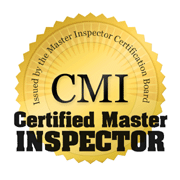Massachusetts Home Inspections YOUR INVESTMENT IS MY CONCERN

Radon Mitigation Installation
While there are various methods available to mitigate radon in a home, Active Soil Depressurization (ASD) is the most common and effective approach for reducing elevated radon levels—particularly here in Massachusetts. Unlike passive systems, ASD utilizes PVC vent piping in combination with a continuously operating fan to actively draw radon from beneath the home and vent it safely outside. This type of system is what I most frequently encounter during home inspections and is strongly recommended by the U.S. Environmental Protection Agency.
INSTALLATION OF THE RADON MITIGATION SYSTEM
1) The concept behind Active Soil Depressurization is straightforward. At the lowest level of the home, a four- to six-inch hole is drilled into the sub-slab. Soil and/or stone are then extracted through the cored hole to create a hollow pit beneath the foundation.
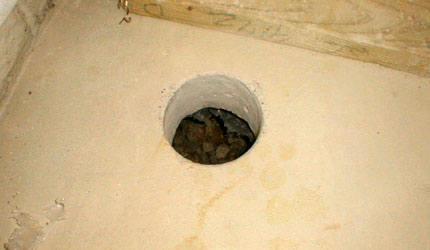
2) Next, a series of PVC pipes are inserted into the drilled hole and securely sealed, running vertically along the foundation or interior walls to ensure proper venting outside the building."
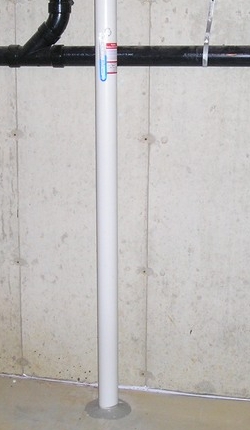
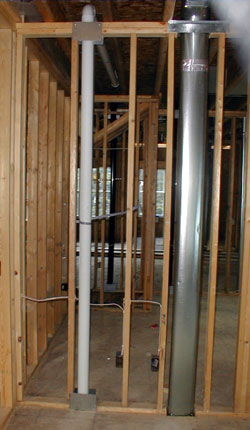
3. The piping will either exit the house at the top of the foundation, extending to the rear exterior of the home (see image on the left), or it may travel through studded walls or closets to reach an unconditioned space, such as the attic (see image on the right). A fan is then installed in series with the piping, penetrating the roof sheathing and terminating above the roofline.
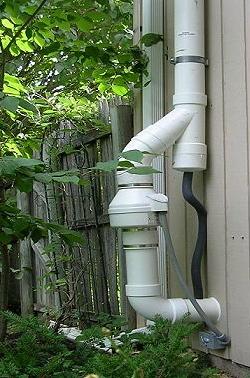
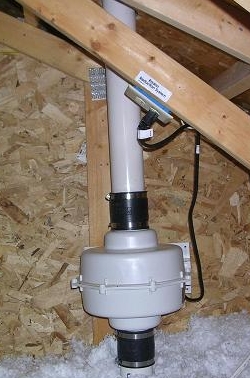
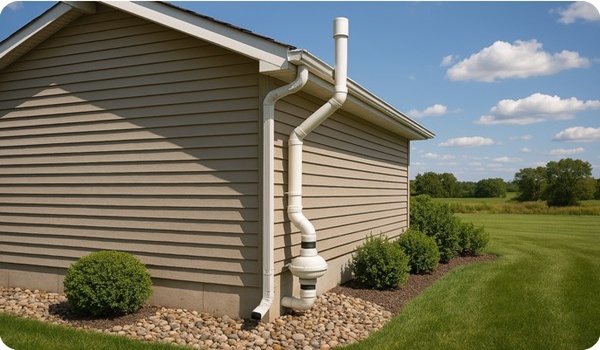
When activated, this fan creates a vacuum beneath the slab, drawing radon-laden soil gas through the piping and safely exhausting it outside the home as per EPA guidelines. All radon entry points are then permanently sealed, and post-installation testing is conducted to verify that the mitigation system is effectively drawing only the gases from beneath the concrete slab.
This type of radon mitigation system includes a monitoring device known as a manometer (see image below). It is your responsibility to periodically check the manometer. The manometer is a pressure gauge mounted on the pipe to assess whether the system is functioning properly and the fan is operating as intended. The manometer should never read zero, which occurs when both liquid lines are equal, as this indicates that the fan is not drawing air through the pipe. You should always observe an offset between the liquid lines, which signals that the radon fan is effectively pulling air from beneath the slab.
MANOMETER
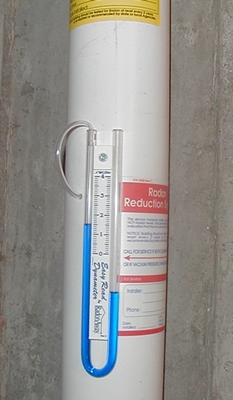
The cost of an Active Soil Depressurization (ASD) system typically ranges from $1,200 to $2,000. This price can vary depending on factors such as the home's design, size, foundation, construction materials, and local climate. Additional costs may arise based on the need to conceal the system and maintain the home's aesthetic appeal. For instance, a retrofit system routed outside the house may effectively reduce radon levels, but it may not be as visually appealing. Overall, the ASD system is successful in lowering radon levels in approximately 99.9% of cases.
Radon Mitigation in new Construction (SSD)
Are you building a new home? A radon sump should be installed while your home is under construction. This passive mitigation system (Sub-Slab Depressurization) will prepare you to activate (install a fan and electrical) inexpensively and effectively at a later date if you find that radon levels are excessive after the house is finally built. Until then, space will be made for the fan (in the attic or unconditioned space), and electrical provisions will be left (optional), and the pipe will exhaust through the roof (above the roof line).
The installation is quite easy for your builder to install before the concrete floor is poured. A sump is buried in hardcore below the floor level of the building. Before the concrete floor is poured, crushed stone is spread out over the ground surface. A high density polyethylene covering (with all seams sealed with construction tape and outside edges sealed to foundation wall) is applied over the stone to trap the radon gases and then divert the gases to the radon sump area by the negative pressure created by the fan.
A perforated pipe or drain mat is placed beneath the plastic. This pipe is typically connected to solid PVC piping and a fan, which creates a vacuum beneath the plastic when the fan is activated. Negative pressure is created in the sump and its surroundings. As the radon percolates up through the ground, it is attracted towards the negative pressure of the sump, where first it is collected then extracted, via a vent pipe through the fan, and finally discharged above roof level to be dispersed harmlessly into the surrounding atmosphere.

There are also other mitigation systems on the market today.
Sub-Membrane Depressurization (SMD)
SMD is performed in crawl spaces and areas that are directly in contact with rock or soil. Suction is created under a specified polyethylene or equivalent flexible material (plastic sheet) permanently installed over exposed soil or rock. Vent piping and a fan draw radon from beneath the plastic sheet and exhaust it outdoors above the highest eave.
Heat Recovery Ventilator (HRV)
When the SSD system is impractical, as is the case where there is an inaccessible crawl space, a Heat Recovery Ventilator (HRV) can be used. These systems work by changing the air in the basement with fresh outside air, which is heated by transferring the heat from the warm inside air to the incoming outside air. Additionally these systems can be adjusted to provide a slight increase in pressure in the basement. The radon reduction thus obtained will be twofold, one due to the dilution of the radon and the other by the retarding effect of the pressure increase.
Sealing Sump Pits and Cracks (picoCure)
In addition to ASD, SSD, SMD, and HRV... picoCURE ensures the effectiveness of the system by sealing sump pits and significant cracks in the basement or foundation. Sump pits are sealed with covers that include view ports. PicoCURE Radon Mitigation systems are quiet, unobtrusive, maintenance-free, and permanently installed.
SOME KEY ELEMENTS TO RADON MITIGATION
✅The discharge shall be at least 10 feet above grade, 10 feet away from any opening that is less than two feet below the discharge, and above or at the eave of the roof.
✅The piping may also be routed up the outside the home, but the discharge must still meet the above criteria.
✅System fans should not be located inside the home or in a crawlspace. They can be in an attic, outdoors, or in a garage, provided there is no living space above the garage.
✅There should be an indicator located in a prominent location (see "Manometer" image above) that will easily indicate to the occupant that the system is functioning properly.
✅Power to the fan should be run in accordance with local electric codes; including permits where required.
✅All portions of the radon mitigation system are to be labeled and a simple instruction manual (with warranties) should be provided to the homeowner.
✅All homes with mitigation systems should be re-tested no sooner than 24 hours (nor later than 30 days) after installation to verify reduction in radon levels. The home should also be retested every two years.
Here is what my clients have to say about my home inspection services:
Press F5 (on your keyboard) for additional testimonials
Hi Dave,
I want to thank you for the home inspection you did for us at 144 Avis Ave. in Dracut MA. We did not get the house because the home owners did not want to split the cost of fixing that wall. I had gotten two estimates, one from a landscaper and one from a Mason. Both gave an estimate of $15,000.00, for which I am grateful for your inspection and pointing out the wall problem. It would of been an undue burden on us, not to mention I am also grateful about the radon testing also. I just got the results today and they came back at 7.5 and 8.4, so that would of been another expense. I do hope that when we find a new house that you will be able to do our home inspection. Your fee was a drop in the hat, to what it would of cost us to fix the wall and then the cost of venting the basement. My husband was also very impressed with your report and how well it was written. Just wanted to drop you a line to let you know what happened, and hopefully will be doing business with you again very soon.
Have a Good Day
Jackie Sliney



